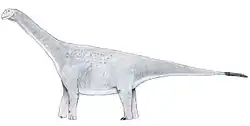| Igai Temporal range: Late Cretaceous, | |
|---|---|
 | |
| Scientific classification | |
| Domain: | Eukaryota |
| Kingdom: | Animalia |
| Phylum: | Chordata |
| Clade: | Dinosauria |
| Clade: | Saurischia |
| Clade: | †Sauropodomorpha |
| Clade: | †Sauropoda |
| Clade: | †Macronaria |
| Clade: | †Titanosauria |
| Family: | †Saltasauridae |
| Genus: | †Igai Gorscak et al., 2023 |
| Type species | |
| Igai semkhu Gorscak et al., 2023 | |
Igai is a genus of titanosaur from the Late Cretaceous Quseir Formation of Kharga Oasis, Egypt. The type species is Igai semkhu.[1]
History
The holotype specimen, VB 621–640, was originally excavated in November 1977 by Karl Werner Barthel and Ronald Böttcher of the Technical University of Berlin (TUB), and sent to Germany in 27 plaster jackets. Due to preparation choices and insufficient storage, the partial skeleton's state of preservation decreased.[1]
The specimen was first mentioned in the scientific literature in a few abstracts in the 1990s. On September 11, 2008, several dinosaur specimens from Egypt and Sudan were transferred to the Museum für Naturkunde, among them most of the Kharga specimen minus the left tibia and an isolated femur. The describers of Igai published more abstracts on it in 2017; work on the specimen was completed in September 2019. In 2023, they were named as belonging to a new genus and species of titanosaur, Igai semkhu. The generic name, "Igai", refers to a mysterious "lord of the oasis" worshipped around the Dakhla and Kharga Oases during the Old Kingdom of Egypt. The specific name, "semkhu", is Ancient Egyptian for "the forgotten", referring both to the specimen's convoluted history and the relatively recent discovery of non-marine Cretaceous vertebrates from continental Africa.[1]
Description

Igai semkhu was relatively slender by titanosaur standards. It is distinguished from other titanosaurs by various details of its limb bones. The fifth metacarpal has two distinct tubercles on its medial side, one near the proximal end and one near the distal end, that are not seen in other titanosaurs.[1] The cnemial crest, a part of the tibia where several leg muscles attach,[2] is smaller and less projected than in other titanosaurs, with Mendozasaurus and juvenile Rapetosaurus being the most similar in this respect.[1] The first and second metatarsals show distinct grooves that are not seen in other titanosaurs.[1]
Based on comparisons with other titanosaurs, Igai has been estimated at 10–15 metres (33–49 ft) in length, larger than the sympatric Mansourasaurus which was 8–10 metres (26–33 ft) long. This reflects a trend where Late Cretaceous titanosaurs from Africa, Europe, and Arabia were small-to-medium sized; additionally, Diamantinasaurus, Epachthosaurus, and Opisthocoelicaudia approached the size of Igai.[1]
Classification
Igai was entered into a phylogenetic analysis and found to be in two possible positions: one as a close relative of the South American Saltasaurus and Neuquensaurus, and another in an Afro-Eurasian clade that includes Lirainosaurus, Opisthocoelicaudia, and the sympatric Mansourasaurus. The authors preferred the second result, since it conforms to a hypothesis that northern African taxa during the Cretaceous were more closely related to European ones while southern African taxa had more Gondwanan origins. The latter cladogram is shown below, with African taxa highlighted in red:[1]
| Titanosauria |
| ||||||||||||||||||||||||||||||||||||||||||||||||||||||||||||||||||||||||||||||||||||||||||||||||||||||||||||||||||||||||||||||||||||||||||||||||||||||||||||||||||||||||||||||||||||||||||||||||||||||||||||||||||||||||||||||||||||||||||||||||||||||||||||||||||||||||||||||||||||||||||||||||||||||
Paleoenvironment
Igai is known from the Quseir Formation, which preserves some of the few non-marine vertebrate remains known from the Late Cretaceous of North Africa. The fellow titanosaur Mansourasaurus is also known from this formation, found in nearby Dakhla Oasis.[3]
See also
References
- 1 2 3 4 5 6 7 8 Gorscak, E.; Lamanna, M. C.; Schwarz, D.; Díez Díaz, V.; Salem, B. S.; Sallam, H. M.; Wiechmann, M. F. (2023). "A new titanosaurian (Dinosauria: Sauropoda) from the Upper Cretaceous (Campanian) Quseir Formation of the Kharga Oasis, Egypt". Journal of Vertebrate Paleontology. e2199810. doi:10.1080/02724634.2023.2199810.
- ↑ Ibiricu, Lucio M.; Martínez, Rubén D.; Casal, Gabriel A. (2020-07-02). "The pelvic and hindlimb myology of the basal titanosaur Epachthosaurus sciuttoi (Sauropoda: Titanosauria)". Historical Biology. 32 (6): 773–788. doi:10.1080/08912963.2018.1535598. eISSN 1029-2381. ISSN 0891-2963.
- ↑ Sallam, H.; Gorscak, E.; O'Connor, P.; El-Dawoudi, I.; El-Sayed, S.; Saber, S. (2017-06-26). "New Egyptian sauropod reveals Late Cretaceous dinosaur dispersal between Europe and Africa". Nature. 2 (3): 445–451. doi:10.1038/s41559-017-0455-5. PMID 29379183.










